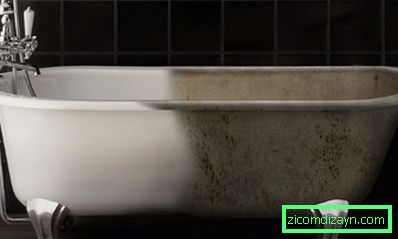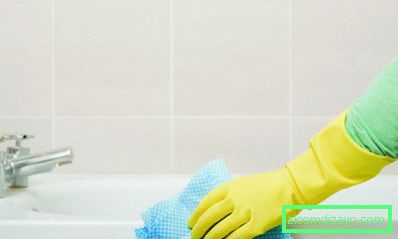Acrylic bath recovery technology
Liquid acrylic can restore the coating of the enamel bath. For this, there is a special method called "bulk". The use of liquid acrylic has replaced the renovation of baths by the method of cold enameling, the main lack of which is to create a fragile and short-lived enamel coating.

The old bath can be restored inexpensively with acrylic.
The later enameling of baths with the composition of liquid acrylic was most popular due to the absence of these drawbacks, which are inherent in cold enamelling. In general, the proper application of acrylic requires a certain skill. Restoration by this method is carried out in two stages. At the first stage, the surface of the bath is prepared, and on the second, acrylic is directly applied to it.
Technology of restoration
Preparation
If you restore the bath with liquid acrylic, it will not have to be dismantled completely. Enameling baths in this way will leave an old siphon, and replace only the drain-overflow grate. The advantages of this method of restoration is the preservation of a comfortable temperature for a long time, as well as the low thermal conductivity of the bath, which acquires a smoothness above the original one. Enameling baths gives them the original look and helps to give the design new properties. At the same time, the coating created can not only preserve the purity, but also prevent pollution. Acrylic practically does not give in to wear, possessing thus the raised durability.
Restored enamel will have a service life of about 15 years, if it is applied correctly. When buying liquid acrylic, you should pay attention to the time it will dry out. If you use a quick-drying compound, the bath will be ready after 24 hours. This type of quick-drying acrylic is inferior to the long-drying composition, since the coating created does not have this strength. The choice of the second type of composition will ensure the availability of a guarantee when using a new enamel. The implementation of the restoration of the baths is not too complicated.

Recovery of the bath with acrylic is done by pouring
Enameling of baths with liquid acrylic composition assumes the initial stage of removing the old coating, for which sandpaper is used. With it, the surface is cleaned. To do this, you must first apply an abrasive cleaning powder. You can also use a drill with an abrasive wheel as a nozzle.
The application of this method is not too time consuming, but leaves enough dirt. This is due to the formation of small dust particles in large quantities. To ensure safety in the process of working with the instrument and nozzle, wear a face respirator.
Completing the treatment of the bath, chip the chips with cracks. If the preparatory stage has been performed correctly, the entire surface will be rough, and this will allow better adhesion of the acrylic composition to the surface.
Stages of enamelling
Degreasing the surface
When the old coating is removed, it is necessary to thoroughly wash off all the dirt that has formed during grinding. Then the bath is completely rinsed with water. Next, degrease the coating using a solvent or ordinary baking soda.

Before applying acrylic, the old bath must be ground and degreased.
It dissolves to the consistency of gruel. Then it is applied to the walls of the bath and its bottom. Further, the entire tank is rinsed with hot water to wash off the gruel. To degrease cracks and chips, the surface should be treated with an autoloader, which is quick-drying.
You can get an even acrylic surface if the previously prepared base is warm. Therefore, the bath is filled with hot water, the temperature level of which is as high as possible. After that, the water is left in the bath for 5-10 minutes. When the water is drained, the surface should be quickly wiped with a tissue napkin that does not leave small villi. Further, dismantling of the overflow and drainage grid is carried out by substituting the container for the drain hole. There should collect all the excess acrylic.
When the equipment is completely ready, go directly to applying liquid acrylic by filling. Use this technology not only for the restoration of acrylic containers, but also for the restoration of the baths of cast iron.
Preliminarily prepare the mixture with which to work. All ingredients of the formulation should be mixed in the required proportions for subsequent mixing. The prepared composition is partially poured into a small reservoir, from where it should be poured into a bath with a thin stream.
Technology pours
The next stage is connected with the acrylic filling, starting from the middle of the bath. Pour acrylic should be on the plumbing device, starting with its edges. It is necessary to make sure that a layer of 4 to 6 cm in size is formed.
The flowing liquid covers about half the surface of the walls of the bowl.
The filling procedure should be carried out evenly, without stopping. Operate until one round of filling is closed. It is necessary to continue pouring in analogy with the previous stage. Further, moving along a spiral, it is necessary to carefully cover the entire tank to restore the bath.
The technology used does not imply the equalization or correction of all the spills with streaks that will inevitably arise during the application of liquid acrylic. When the drying process is completed, all the unevenness appearing during filling will disappear, and the coating of the bath will become even. To collect excess solution use special dishes, which is installed under the drain hole. Restoring the bath with the use of liquid acrylic necessarily requires strict adherence to the instructions in the instructions.

After each use of the bath it must be wiped dry to avoid the appearance of plaque.
The label on the package of acrylic fluid should contain information about the time it takes to dry the mixture. At this time, it is best not to go close to the bath, because the state of the acrylic treated surface can be affected by small debris or drops of water that accidentally hit the drying acrylic coating. Accurate handling of the surface of the equipment is a guarantee of a long service life of acrylic coating.
To ensure that the life of the acrylic bath is long enough, you should treat it with caution. It is characterized by high strength and resistance to the appearance of various scratches and cracks.
However, it is sensitive to deformation and significant damage. To handle the bathroom you need maximum care. Inside the tub should not fall heavy objects, its surface should not experience severe shocks.
The bath must be wiped dry every time after use. Strong contamination of the enamel is not allowed, as abrasive cleaning agents are not allowed for cleaning. To cope with the contamination will help the powder for washing or a dishwashing detergent.
Enameling baths with acrylic coating does not allow soaking the laundry using a bleach containing a sufficient amount of dyes. Enamel can also be damaged by using an aggressive chemical composition.
In general, the restoration of baths with liquid acrylic without much difficulty, and the successful use of equipment will depend on the fulfillment of the requirements for operation.